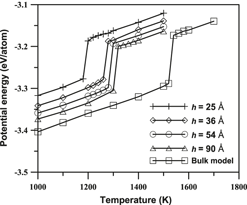Article contents
Influence of film thickness and surface orientation on melting behaviors of copper nanofilms
Published online by Cambridge University Press: 13 February 2014
Abstract

The effects of film thickness and surface orientation on melting behaviors of copper nanofilms were investigated by molecular dynamics simulations. A stepwise heating scheme was adopted to make sure that the nanofilms reached thermal equilibrium before further temperature increase. Melting of the nanofilms was monitored by examining the equilibrium potential energy, radial distribution function, and mean square displacement of the simulated nanofilms. From the simulation, the melting was observed to occur at a specific temperature within 1 K error, unlike the progressive melting process reported in the literature. The melted temperature and the latent heat of fusion of the nanofilms were found to increase with film thickness and approach the bulk value. The nanofilms with (111) surface have the highest melted temperature and the largest latent heat of fusion as compared to the ones with (001) and (011) surfaces, which could be explained by the lowest surface energy of (111) surface.
- Type
- Articles
- Information
- Copyright
- Copyright © Materials Research Society 2014
References
REFERENCES
- 5
- Cited by




